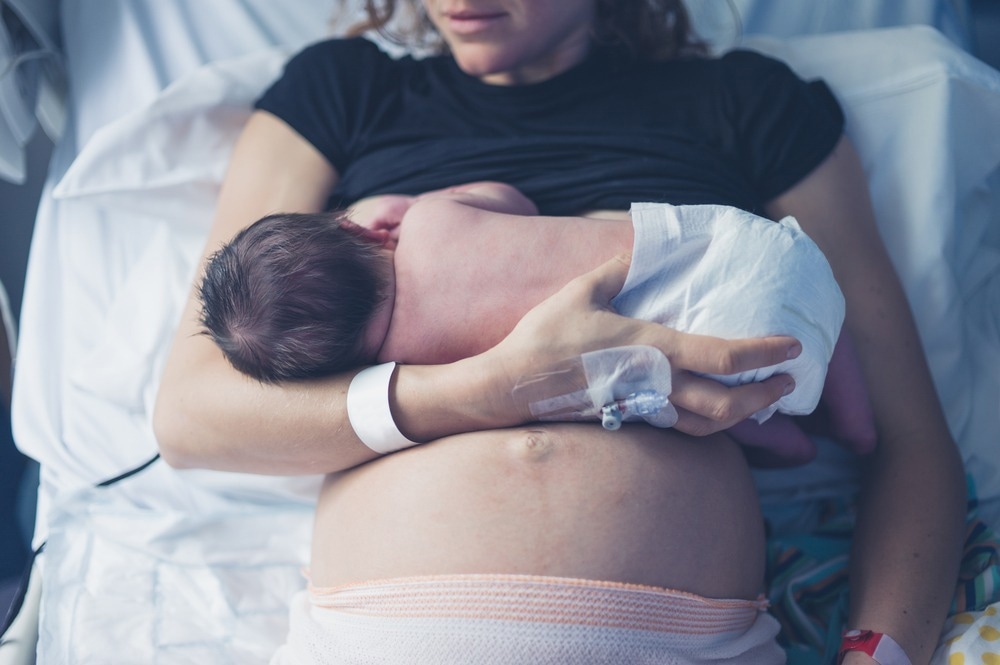What are the Stages of Labor and Childbirth?
Stage 1: Cervix thinning and opening
Stage 2: Baby movement in the birth canal
Stage 3: Afterbirth and recovery
Challenges
Conclusion
References
Further reading
Labor or childbirth can be described as a fetus and placenta delivered from the uterus via the vagina. Having a successful labor can be dependent on three factors, including maternal effort and uterine contractions, fetal characteristics, and pelvic anatomy. Labor can be divided into three stages, including (i) labor, (ii) pushing and birth, and (iii) delivery of the placenta. The first of these stages is the longest and comprises early labor, active labor, and the transition phase.

Image Credit: christinarosepix/Shutterstock.com
Stage 1: Cervix thinning and opening
Early labor
The early phase of labor includes the onset of labor which continues until the cervix is dilated to between 3-6 cm and can typically take 6-12 hours. The active labor phase has been determined by the cervix measuring between 3 cm and 7 cm of dilation. The transition phase continues from 7 cm until the cervix is fully dilated to 10 cm.
During this phase, women are likely to feel mild and irregular contractions every 5 to 15 minutes, lasting between 60 and 90 seconds. As the cervix begins to open, clear pink or slightly bloody discharge may be released by the vagina, known as the mucus plug, which works to block the cervical opening during pregnancy. The contractions cause the cervix to become thinner, and it opens to about 3–6 cm by the end of the early phase.
In some cases, the amniotic sac may rupture, resulting in vaginal bleeding, in which case, it may be beneficial to note the liquid's color and odor. If heavy bleeding or period-like bleeding is experienced, a healthcare provider should be notified immediately.
Active labor
In the active labor phase, contractions have been described as stronger and lasting longer, causing more pain. The time between contractions decreases in active labor, and the cervix opens between 4–7 cm wide, resulting in pressure in the lower back area.

Image Credit: Natalia Deriabina/Shutterstock.com
Contractions occur at a frequency of 3–5 minutes, lasting approximately 45–60 seconds and signaling the faster opening of the cervix. It is estimated that the cervix opens at a rate of a single centimeter within an hour. During the active labor phase, expectant mothers should proceed to the hospital to prepare for delivery.
Once labor progresses, waters may break, and contractions may speed up. When labor progresses to the second stage, the cervix has opened completely, measuring up to 10 cm.
Transition phase
The transition phase is the most difficult and painful stage, lasting between 15 minutes and an hour. The frequency of contractions is closer, at approximately 2–3 minutes and lasting 60–90 seconds. Pressure is also experienced within this stage at the lower back and rectum region, and the sensation to push may be more demanding.
Stage 2: Baby movement in the birth canal
The second stage of labor is defined by a fully dilated cervix, signaling being ready to give birth. This stage is the most physically demanding due to pushing the baby out.
This stage can take 20 minutes or more, depending on the size, position of the baby, and the number of previous deliveries. In first-time mothers or those given an epidural, a common labor pain medication provided through a tube in your lower back to numb the lower body, this stage can last a few hours.
Contractions may slow to every 2–5 minutes, lasting 60-90 seconds. An episiotomy, known as a small surgical cut, can also be made at the vaginal opening to help with the delivery of the baby; however, this is not required for most women. As the head of the baby is emerging or crowning, the baby is guided out of the birth canal, with special equipment used if required. Once the baby is born and birthed, the umbilical cord is cut.
Stage 3: Afterbirth and recovery
During this stage, the placenta, which grows in the uterus, supplies food and oxygen to the baby through the umbilical cord. The third stage is characterized by contractions that begin approximately 5-30 minutes after the birth of the baby; however, this is the shortest stage, taking up to 20 minutes.

Image Credit: Lolostock/Shutterstock.com
Interestingly, after the delivery of the placenta, women continue to experience contractions, for which medicine can be provided, which can also prevent heavy bleeding. If an episiotomy was undertaken, this is now repaired. Additionally, the umbilical cord, cut after the delivery, can be stored for later use or donation to treat diseases such as cancer.
Once the baby's birth is complete, breastfeeding can start immediately, with many cases beginning within an hour of birth, and this can also help contract the uterus and reduce bleeding. Skin-to-skin contact can also help the baby acclimate to being outside the womb.
Challenges
Some possible challenges or complications could be faced during any of the stages of labor that may lead to an abnormal labor. This can include experiencing an arrest of childbirth, in which case a cesarian delivery would be required. This can carry both a higher risk to the mother and fetus.
Complications during the second stage include trauma to the delivery process, such as the fetus suffering from fractures, nerve palsies, scalp hematomas, and anoxic brain injuries. Traumatic complications to the mother can range from uterine rupture, hemorrhage, vaginal or cervical laceration, amniotic fluid embolism, and even death. Additionally, complications during the third stage of labor can include hemorrhage, retained placenta, or incomplete removal of the placenta.
Conclusion
While pregnancy or delivery-related complications can lead to death in 700 women each year in the United States, according to the Centers for Disease Control and Prevention (CDC), most deliveries occur without challenges or complications if performed by a doctor in a hospital setting with a good emergency care facility.
Periods or menstruation can start again after giving birth from between five to six weeks if breastfeeding in combination with bottle feeding but may take longer if fully breastfeeding until this is reduced; however, this can be difficult to predict due to individual differences. Additionally, it is possible to also become pregnant again from as little as three weeks after giving birth, even if breastfeeding and without the re-emergence of periods.
References
- American Pregnancy Association, Stages of Labor: Stage 1, http://americanpregnancy.org/labor-and-birth/first-stage-of-labor/ (Accessed: December 15, 2022).
- Hutchison J, Mahdy H, Hutchison J. Stages of Labor. [Updated 2022 Sep 12]. In: StatPearls [Internet]. Treasure Island (FL): StatPearls Publishing; 2022 Jan-. Available from: https://ncbi.nlm.nih.gov/books/NBK544290/
- Kaiser Permanente, The Four Stages of Labor, https://www.ghc.org/healthAndWellness/?item=/common/healthAndWellness/pregnancy/birth/laborStages.html (Accessed: December 15, 2022).
- March of Dimes, Stages of Labor, http://www.marchofdimes.org/pregnancy/stages-of-labor.aspx (Accessed: December 15, 2022).
- Mayo Clinic, Labor and Delivery, Postpartum Care, http://www.mayoclinic.org/healthy-lifestyle/labor-and-delivery/in-depth/stagesof-labor/art-20046545 (Accessed: December 15, 2022).
- Your Body After the Birth (2021) NHS choices. NHS. Available at:https://www.nhs.uk/pregnancy/labour-and-birth/after-the-birth/your-body/ (Accessed: December 15, 2022).
- Rohini Radhakrishnan, E.N.T. (2021) How common are complications during childbirth?, MedicineNet. MedicineNet. Available at: https://www.medicinenet.com/how_common_are_complications_during_childbirth/article.htm (Accessed: December 15, 2022).
Further Reading
- All Labor Content
- Natural Childbirth
- Labor: what is the “show”?
- Nitrous Oxide for Labor: Choose Wisely
- Breeched Birth: Caesarean Section or Vaginal Delivery?
Last Updated: Dec 20, 2022

Written by
Marzia Khan
Marzia Khan is a lover of scientific research and innovation. She immerses herself in literature and novel therapeutics which she does through her position on the Royal Free Ethical Review Board. Marzia has a MSc in Nanotechnology and Regenerative Medicine as well as a BSc in Biomedical Sciences. She is currently working in the NHS and is engaging in a scientific innovation program.
Source: Read Full Article
